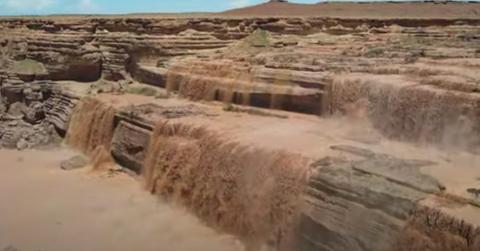Arizona’s “Chocolate Waterfall” Is a Seasonal Spectacle Heavily Impacted by Climate Change
Published Aug. 15 2022, 12:23 p.m. ET
Arizona is home to so many breathtaking natural beauties, from the Grand Canyon to Havasu Falls. But something that's made headlines recently is Arizona's chocolate waterfall, aka Chocolate Falls. Formally known as Grand Falls, the iconic tourist attraction coined its nickname for its resemblance to the iconic Willy Wonka scene.
But how was this created, and why is it being impacted by climate change?
Chocolate Falls has gained tremendous attention from nature lovers nationwide.
"Sightseers in Arizona witnessed a natural phenomenon that resembled a scene out of the movie Willy Wonka and the Chocolate Factory, but they didn’t need a golden ticket to see the breathtaking sight, just some rain and a bit of luck," meteorologist Brian Lada writes for AccuWeather.
With the arid summer weather, though, it may not exist much longer.
"The chocolate milk-colored water that cascades down the 181-foot cliff is the inspiration behind its nickname of Chocolate Falls," he continues. "There is no fee for visiting the Chocolate Falls, according to the Navajo Tourism Department, but visitors should watch the weather forecast carefully if they want to witness the wondrous waterfall firsthand."
What causes Arizona's Chocolate Waterfall?
Arizona's Chocolate Falls, which are located approximately 41 miles from Flagstaff, are like Niagara Falls' taller, darker, and more delicious-looking older sibling.
According to AZ Central, Chocolate Falls' 185-foot plunge outdoes Niagara's 167-foot drop by almost 20 feet. Its chocolatey brown coloring reminds onlookers of Willy Wonka — hence its name — though unfortunately, the roaring falls doesn't consist of actual chocolate... what a disappointment.
Instead, the waterfall's cocoa hue comes from slow melting snow and silt rushing in from the Colorado River, which feeds into it.
The beloved Chocolate Waterfall is dry for the majority of the winter, but it effectively comes to life in the spring and summer when the snow starts to melt. It's located on the Navajo Reservation so the surrounding natural lands are mostly untouched. But it's open to visitors, and doesn't require any permits to visit — so treat it with care.
Sometimes if you're lucky, you can catch a rainbow amid the chocolatey goodness. But the waters really have to be roaring for a rainbow to appear.
Because of recent unusually dry conditions, however, Chocolate Falls might not be around for much longer this season. And if climate change continues to plague our planet, the iconic Arizona attraction could cease to exist very soon.
How are Arizona's Chocolate Falls impacted by climate change?
The ability to catch a glimpse of the iconic waterfall is based on water levels. Fortunately, you can check them ahead of time, so you aren't potentially disappointed. But if there wasn't a ton of snow in the northern parts of the Colorado River, and if the season is too dry, you might be SOL. And because climate change is likely to make for drier conditions in the future, Chocolate Falls may not be around much longer.
That said, we're hoping for the best — and planning a trip as we speak.
